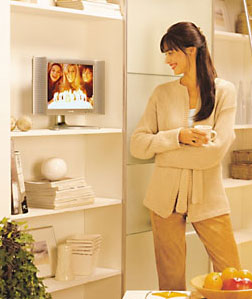|
What exactly is a Liquid
Crystal Diode (LCD) TV?
LCDs are all around us. Liquid crystal displays so prevalent, in fact,
that most people couldn't get through their day without using one.
This technology is utilized in digital clocks, microwave ovens, car dashboards,
calculators, stereos, thermometers, and even some bathroom scales!
The applications for liquid crystal displays are almost limitless,
so it should come as no surprise that this technology has revolutionized the
most basic home appliance of all-the television set.
Liquid crystal technology has given birth to those slim, cool-looking,
bright displays that are popping up everywhere from bank lobbies to
living rooms. But how does it work?
What makes a crystal "liquid"?
The twisted nematic (TN) liquid crystal is the most common type of
liquid crystal being used in display applications today
(e.g., LCD televisions, LCD monitors, and LCD projectors).
It has a naturally twisted crystalline structure.
A particular feature of this crystal is that it reacts
to electric currents in predictable ways-i.e., by untwisting
to varying degrees depending on the voltage of the current to
which it is exposed. Hence the "liquid" part of the crystal's moniker:
Rather than being an oxymoron (How can a solid also be a liquid?),
the term refers to the relative pliability of the crystals themselves,
which is to say, their twistability.
|
 |

|









